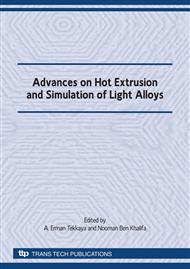p.19
p.27
p.35
p.43
p.51
p.57
p.65
p.71
p.79
Simulation of the Quench Sensitivity of the Aluminum Alloy 6082
Abstract:
A method for the numerical estimation of the final hardness distribution of heat treated aluminum alloys was developed and implemented into a commercial finite element (FE) tool. Jominy end-quench tests were carried out in order to determine the quench sensitivity of the aluminum alloy EN AW-6082. The hardness distribution of the alloy after end-quenching was related to the corresponding cooling rates. The derived relation was tested for an industrial application by investigating the local heat treatment of a prototype crash absorbing structure. Numerical estimations were validated with experimental measurements. Effectiveness of the derived method and possible improvements were discussed.
Info:
Periodical:
Pages:
51-56
Citation:
Online since:
December 2009
Authors:
Price:
Сopyright:
© 2010 Trans Tech Publications Ltd. All Rights Reserved
Share:
Citation:


